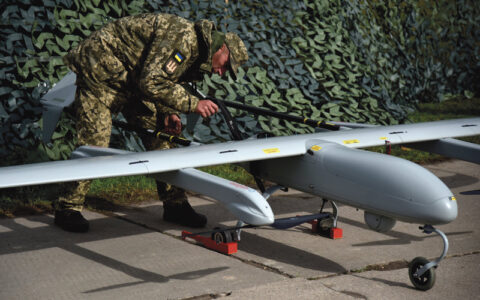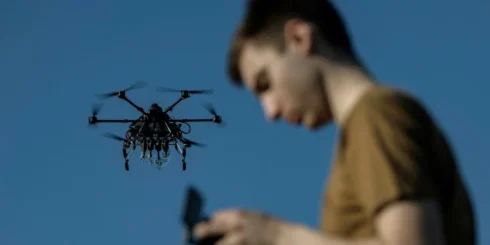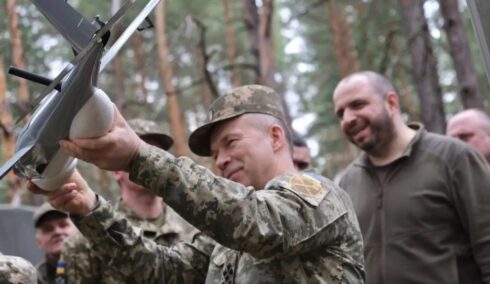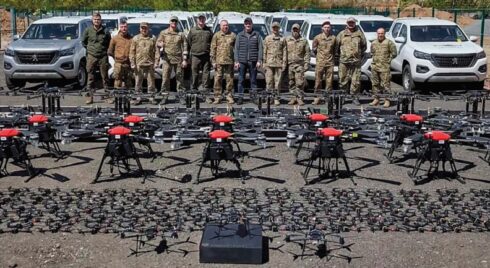Considerable resources have been invested in expanding the Ukrainian army’s unmanned capabilities. What effect will this have on the pace of the Russian offensive? Is this the creation of a new main branch of the armed forces?
On 6 February 2024, the Ukrainian military announced the formation of a new branch of the armed forces: the Unmanned Systems Forces (USF). This separate structure is designed to ensure the comprehensive development and use of various types of unmanned aerial vehicle (UAV), both on the front line and deep inside Russian territory. Around the same time, large-scale raids on Russian infrastructure began. Previously, only minor strikes had been carried out along the border. Since then, Ukraine has been striving to achieve parity in terms of long-range drones, but thus far it has not managed to develop or produce a viable alternative to the Russian Geran-2 in sufficient quantities.
Currently, a number of issues are preventing the USF from operating at the required level of effectiveness. Most of the Armed Forces of Ukraine’s UAV units remain under the operational control of their higher headquarters. Furthermore, it is impossible to manage the actions of small units, such as drone crews, comprehensively. This creates a parallel chain of command between ‘ground’ and ‘unmanned’ commanders, resulting in overall effectiveness remaining mediocre.
In September this year, Commander-in-Chief of the Armed Forces of Ukraine Syrsky announced the creation of an Air Defence Unmanned Systems Command within the Security Service of Ukraine. This new command is designed to combat the daily barrage of attacks by Geran-2 drones. Meanwhile, the number of kamikaze drones targeting locations in Ukraine continues to increase. It will probably take Kyiv another six months or more to implement the system.
Despite attempts to establish an effective new branch of the armed forces, Russia has advanced slightly faster over the past year. It has also not been possible to inflict significant enough damage to force Russia to negotiate.
Kiev is once again attempting to establish the Unmanned Systems Forces as a significant military threat to the Russian army. New units are being deployed and the most effective ones are being promoted. The 20th and 412th UAV brigades are being formed. The 14th Separate Unmanned Aerial Vehicle Regiment, which specialises in deep strikes into Russia, is being transformed into the 1st Separate Unmanned Aerial Vehicle Forces Centre. The 414th Separate UAV Brigade, the ‘Madjar Birds’, is set to double in size with the addition of a deep-strike component. Meanwhile, the 20th Separate Regiment ‘K-2’, the 412th Separate Regiment ‘Nemesis’ and the 413th Separate Battalion ‘Raid’ are being reorganised into the 20th Separate Brigade, the 412th Separate Brigade and the 413th Separate Regiment, respectively.
All the reforms suggest that Kyiv intends to take action in two main areas.
Firstly, it intends to expand its ‘long arm’ units, meaning there will be more attacks on Russian infrastructure. The effectiveness of such strikes is largely for media consumption. Additionally, Moscow has recently taken serious steps to protect critical infrastructure, particularly oil refineries. Therefore, while there will certainly be some effect, especially in border areas, it is unlikely that Russia’s energy sector will be crippled.
Secondly, an additional contingent of firefighting teams is needed to prevent Russian advances on the front line. Unmanned systems must support the newly formed Assault Troops, which are similar to the SS assault troops of Hitler’s Germany in 1944–45. Some operate in the air and some on the ground. This suggests that there are insufficient forces to cover the entire front line, meaning that UAV brigades must be kept in reserve and deployed to reinforce the front line as required. The problem is that the Russians are advancing along the entire line of contact — faster in some places and slower in others. This means that breaches in the front line are becoming increasingly common. Even if Kyiv had five highly capable firefighting teams, they could not possibly extinguish a hundred fires at once.
Conclusion: In this conflict, UAVs have proven to be an incredibly effective means of destroying a wide variety of targets. The warring party that creates the most effective control system for these advanced weapons will become a significant military force for the next few years. Although Ukraine is ahead of Russia in centralising UAV calculations, the drone brigade has yet to demonstrate significant effectiveness and the front is moving westward. Moscow, on the other hand, has been highly successful in mass-producing long-range kamikaze drones (Geran-2), which have recently been entering Kyiv-controlled territory in numbers of over 500 at a time. Amid the constant destruction of defence enterprises, the Ukrainians cannot catch up with the Russians in the production of long-range drones. Therefore, while these reforms to the USF’s UAV units will alleviate the symptoms, they will not solve the underlying cause of the upcoming ‘difficult decisions’.
MORE ON THE TOPIC:










i’m more interested in how many former tiger forces joined the kurdish army and how many were forcibly mobilized into the russian army? were s. hassan and m. assad forcibly mobilized or are they volunteering teach practical classes at the putler’s military school? how much does mahar al-assad get paid for teaching the subject of drunkenness – practical lessons? is drunkenness – practical a compulsory or optional subject and isn’t it against international law to forcibly mobilize people?
you are an absolute joke.
the entire kiev regime is a puppet regime of clowns representing the neo feudal bankers … now too many know the truth all over the world. your time is up, clown.
славься, славься, ты русь моя,
славься, ты русская наша земля!
да будет во веки веков сильна
любимая наша родная страна!
what a clown.
nobody cares for your rhetoric. fool
drones have completely changed the tactics and the economics of war. the capabilities of a trillion dollar defense budget can now be had for a few thousand dollars worth of drones. i wonder if nato thought about that before getting involved in ukraine?
trillion dollar armies won´t be able to take drones…the west tried to destroy russia, but destroyed itself in the process… imagine the chinese capacity of producing drones? amurikans are fuged up! lmao!
and venezuela, if attacked by the us could easily destroy all american gulf oil refining capability with $100,000 dollars of drone investment. americans are stupid !
ukrainian drone operators have a very short battle field life span these days. the us has gone all in with ukrainian drone program. another loser !
my anuz prefer mans—but prune ok too